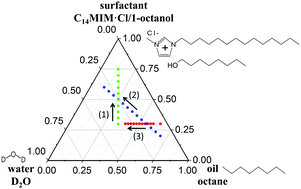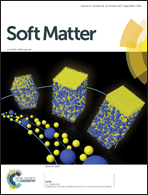Abstract
Mixtures of water, octane and 1-octanol with 1-tetradecyl-3-methylimidazolium chloride (C14MIM·Cl), often referred to as a surface active ionic liquid (SAIL), form water-in-oil microemulsions that have potential application as extraction media for various metal ions. Here, we present a structural study by small-angle neutron scattering (SANS) of dense microemulsions formed by surfactant-rich mixtures of these four compounds to understand how the SAIL can be used to tune the structures and properties of the microemulsions. The SANS experiments revealed that the microemulsions formed are composed of two phases, a water-in-oil microemulsion and a bicontinuous microemulsion, which becomes the dominant phase at high surfactant concentration. In this concentration regime, the surfactant film becomes more rigid, having a higher bending modulus that results from the parallel stacking of the imidazolium ring of the SAIL. At lower surfactant concentrations, the molecular packing of the SAIL does not change with the water content of the microemulsion. The results presented here correlate well with previously observed changes in the interaction between the IL cation and metal ions (Y. Tong, L. Han and Y. Yang, Ind. Eng. Chem. Res., 2012, 51, 16438–16443), while the capacity of the microemulsion system for water remains high enough for using the system as an extraction medium.



 Please wait while we load your content...
Please wait while we load your content...